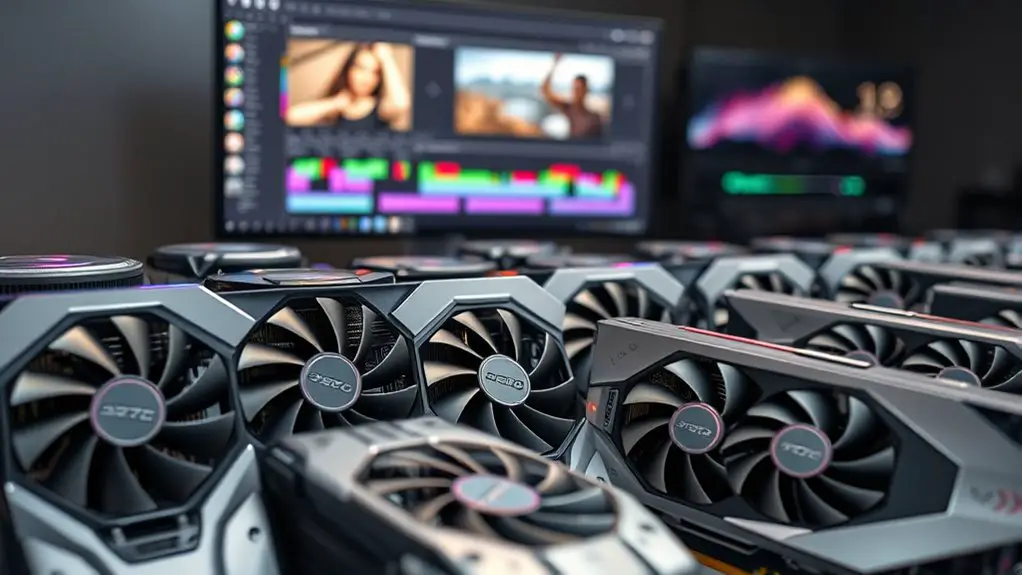When choosing the best GPUs for video editing and rendering, you'll want to take into account performance and VRAM. NVIDIA's RTX series is great for rendering speed, while AMD's Radeon lineup excels in color accuracy. For budget options, the GTX 1650 or RX 550 can work well for basic tasks. If you're handling 4K projects, aim for high-end GPUs like the RTX or Radeon RX series. Want to know what else to take into account? There's much more to explore.
Top GPUs for Professional Video Editing
When it comes to professional video editing, selecting the right GPU can make all the difference in your workflow and final output. Leading GPU brands like NVIDIA and AMD offer powerful options tailored for video editing needs. You'll want to evaluate VRAM requirements carefully; a minimum of 6GB is often recommended for smooth 4K editing. Higher VRAM not only enhances performance but also allows for more complex projects without lag. For instance, NVIDIA's RTX series provides exceptional rendering speeds and real-time ray tracing, while AMD's Radeon lineup excels in color accuracy. Ultimately, choosing a GPU that aligns with your editing style and project demands will empower your creative freedom, ensuring you can bring your vision to life without technical restrictions.
Best Budget GPUs for Video Editing
For those on a budget, finding a GPU that balances performance and cost for video editing can be a challenge, but it's definitely possible. Here are some affordable options that deliver solid entry-level performance:
Finding an affordable GPU that balances performance and cost for video editing is challenging yet achievable.
- NVIDIA GeForce GTX 1650 – Great for basic editing tasks and supports most modern software.
- AMD Radeon RX 550 – An excellent choice for users who need decent performance without breaking the bank.
- NVIDIA GeForce GTX 1660 Super – Offers a sweet spot for budget-conscious creators looking for more power.
- AMD Radeon RX 580 – A versatile card that handles 1080p editing smoothly, making it a reliable pick.
These GPUs will help you release your creative potential without straining your wallet.
High-End GPUs for 4K and Beyond
As you aim to take your video editing to the next level, investing in a high-end GPU becomes essential for seamlessly handling 4K projects and beyond. These powerhouses are designed for high performance rendering, enabling you to edit, render, and export 4K videos with ease. With advanced architectures and ample VRAM, they guarantee smooth playback of high-resolution footage, drastically reducing lag during the editing process. GPUs like the NVIDIA GeForce RTX series or AMD Radeon RX series stand out for their impressive 4K video capabilities, offering features like real-time ray tracing and AI enhancements. This level of performance not only elevates your workflow but also grants you the freedom to explore complex projects without compromise.
Factors to Consider When Choosing a GPU
Choosing the right GPU for video editing isn't just about picking the latest model; it requires careful consideration of several key factors. Here are four vital elements to keep in mind:
Selecting an ideal GPU for video editing entails more than just the newest model; it demands thoughtful evaluation of essential factors.
- GPU Compatibility: Confirm the GPU works seamlessly with your motherboard and software.
- Cooling Solutions: Opt for models with efficient cooling systems to avoid overheating during intensive tasks.
- Power Consumption: Take into account the power requirements to make sure your system can handle the load without issues.
- VRAM Capacity: Higher VRAM is essential for handling large files and multiple applications simultaneously, especially in 4K editing.
Performance Benchmarks of Leading GPUs
While the specifications of a GPU provide a glimpse into its capabilities, performance benchmarks reveal the real-world differences that can considerably impact your video editing workflow. Different GPU architectures play a vital role in determining rendering speed and overall performance. For instance, NVIDIA's Ampere architecture excels in tasks requiring parallel processing, making it a favorite for 4K editing. Meanwhile, AMD's RDNA 2 architecture offers impressive performance and efficiency, especially in rendering high-resolution textures. When comparing benchmarks, look for metrics like render times and frame rates during playback. These insights help you identify which GPU delivers the best value for your specific needs, ensuring you can work efficiently without unnecessary delays in your creative process.
Frequently Asked Questions
Can I Use Integrated Graphics for Video Editing?
You can use integrated graphics for video editing, but you'll face performance limitations. While it's suitable for basic tasks, demanding projects may require a dedicated GPU to release your editing potential and enhance efficiency.
How Important Is VRAM for Video Editing Performance?
VRAM capacity and speed are essential for video editing performance. More VRAM lets you handle larger projects smoothly, while faster VRAM speeds up data transfer, enhancing your overall editing experience and creative freedom.
Do Video Editing Software Programs Favor Specific GPU Brands?
When considering GPU brands, you'll notice NVIDIA dominance in software compatibility and performance, while AMD performance offers unique advantages. Ultimately, your choice should align with your specific editing needs and desired software optimizations.
Is Driver Support Crucial for Video Editing GPUS?
Isn't having reliable driver support essential for performance? You'll find that driver stability and software compatibility greatly influence your editing experience, ensuring smooth workflows and minimizing frustrating hiccups during your creative projects.
How Often Should I Upgrade My GPU for Video Editing?
You should consider upgrading your GPU every three to five years, depending on performance needs and advancements. A GPU's lifespan often dictates how frequently you'll need to upgrade to maintain peak efficiency in your editing tasks.

